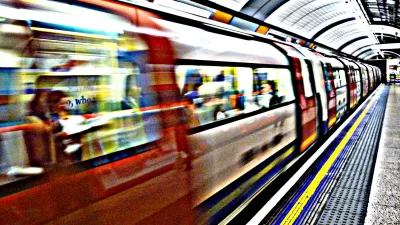Dave Hill reflects on the history and outlook for the world's first underground train. He beckons Londoners to do the same, and to contemplate on how to best help the London Underground flourish in the future.
Nearing the anniversary of the day London's first underground train made the three-and-a-half mile trip from Paddington to Farringdon, Hill calls on Londoners to stop their whining about the Tube, and to instead be thankful that after 150 years, the Underground -- delays, upgrades and all -- is still in service. He takes a look back at its history, highlighting low points of “atrophy of decline”, and high points, such as the creation of the Greater London Council (GLC), in the mid-twentieth century, which invested in much-needed improvements in the face of growing car ownership. He also cites significant moments during the late 20th century, including the abolition of the GLC, the tragic Kings Cross fire, and the recession of the 1990s, which resulted in funding and organizational overhauls.
After a decade of reinvestment, upgrade completions [PDF] and continued expansion, Hill is optimistic that “the future of the London Underground looks brighter than at any time since the suburban expansion of the 1930s.” He also warns, however, that as London continues to grow, “bigger and bolder solutions to the capital's transport problems are needed.” Hill points out that future upgrades and enhancements are dependent upon fare increases, which is unwelcome news to London's working classes, and questions the connection between the selection of routes and funding priorities and real estate speculation.
In light of this, Hill asks, “Is the Tube to become complicit in the growth and "regeneration" of London into a place increasingly tailored to the needs of the very affluent?” He concludes by inviting thoughts and insights on “viable alternatives” to this scenario, which several commenters have taken him up on.
FULL STORY: London Underground at 150: its past and future

Maui's Vacation Rental Debate Turns Ugly
Verbal attacks, misinformation campaigns and fistfights plague a high-stakes debate to convert thousands of vacation rentals into long-term housing.

Planetizen Federal Action Tracker
A weekly monitor of how Trump’s orders and actions are impacting planners and planning in America.

In Urban Planning, AI Prompting Could be the New Design Thinking
Creativity has long been key to great urban design. What if we see AI as our new creative partner?

King County Supportive Housing Program Offers Hope for Unhoused Residents
The county is taking a ‘Housing First’ approach that prioritizes getting people into housing, then offering wraparound supportive services.

Researchers Use AI to Get Clearer Picture of US Housing
Analysts are using artificial intelligence to supercharge their research by allowing them to comb through data faster. Though these AI tools can be error prone, they save time and housing researchers are optimistic about the future.

Making Shared Micromobility More Inclusive
Cities and shared mobility system operators can do more to include people with disabilities in planning and operations, per a new report.
Urban Design for Planners 1: Software Tools
This six-course series explores essential urban design concepts using open source software and equips planners with the tools they need to participate fully in the urban design process.
Planning for Universal Design
Learn the tools for implementing Universal Design in planning regulations.
planning NEXT
Appalachian Highlands Housing Partners
Mpact (founded as Rail~Volution)
City of Camden Redevelopment Agency
City of Astoria
City of Portland
City of Laramie




























